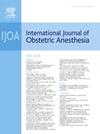复苏子宫切开和机械循环支持对已知胎盘增生谱患者继发肺栓塞的产妇心脏骤停一例报告
IF 2.3
3区 医学
Q2 ANESTHESIOLOGY
引用次数: 0
摘要
产妇心脏骤停是产科罕见但严重的事件,其结果在很大程度上取决于有效的多学科管理。我们报告的情况下,一个30岁的孕妇胎盘增生谱(PAS),一个大的胎盘血肿,子宫开裂。在住院期间,她接受了保守治疗,直到24 + 6周,她因大量肺栓塞而发生心脏骤停。在确认心内血栓后,行复苏式剖宫产术和机械循环支持,并开始静脉动脉体外膜氧合(VA-ECMO)。患者因PAS出血失控,并发大出血和凝血功能障碍,需要紧急子宫切除术。尽管情况复杂和严重,但产妇和新生儿的结局最终都是有利的。患者在心脏骤停后26天无神经功能障碍出院;这名新生儿在足月适龄时健康出院。本病例强调了个体化血栓预防的必要性,并强调了专门中心在管理高危妊娠中的关键作用。在这种危及生命的情况下,多学科护理、及时的应急反应和先进的生命支持措施是取得成功的关键。本文章由计算机程序翻译,如有差异,请以英文原文为准。
Resuscitative hysterotomy and mechanical circulatory support for maternal cardiac arrest secondary to pulmonary embolism in a patient with known placenta accreta spectrum: a case report
Maternal cardiac arrest is a rare but severe event in obstetrics, with outcomes largely dependent on effective multidisciplinary management. We report the case of a 30-year-old pregnant woman with placenta accreta spectrum (PAS), a large placental hematoma, and uterine dehiscence. During her inpatient stay, she was conservatively managed until 24 + 6 weeks, when she suffered sudden cardiac arrest due to massive pulmonary embolism. Resuscitative hysterotomy and mechanical circulatory support was performed and venoarterial extracorporeal membrane oxygenation (VA-ECMO) was initiated following identification of intracardiac thrombus. The patient required emergency hysterectomy due to uncontrolled PAS bleeding, complicated by massive hemorrhage and coagulopathy. Despite the complexity and severity of the situation, both maternal and neonatal outcomes were ultimately favorable. The patient was discharged home without neurological deficits 26 days after cardiac arrest; the neonate was discharged in good health at term-equivalent age. This case highlights the need for individualized thromboprophylaxis and underscores the critical role of specialized centers in managing high-risk pregnancies. Multidisciplinary care, prompt emergency response, and advanced life support measures were key to the successful outcome in this life-threatening scenario.
求助全文
通过发布文献求助,成功后即可免费获取论文全文。
去求助
来源期刊
CiteScore
4.70
自引率
7.10%
发文量
285
审稿时长
58 days
期刊介绍:
The International Journal of Obstetric Anesthesia is the only journal publishing original articles devoted exclusively to obstetric anesthesia and bringing together all three of its principal components; anesthesia care for operative delivery and the perioperative period, pain relief in labour and care of the critically ill obstetric patient.
• Original research (both clinical and laboratory), short reports and case reports will be considered.
• The journal also publishes invited review articles and debates on topical and controversial subjects in the area of obstetric anesthesia.
• Articles on related topics such as perinatal physiology and pharmacology and all subjects of importance to obstetric anaesthetists/anesthesiologists are also welcome.
The journal is peer-reviewed by international experts. Scholarship is stressed to include the focus on discovery, application of knowledge across fields, and informing the medical community. Through the peer-review process, we hope to attest to the quality of scholarships and guide the Journal to extend and transform knowledge in this important and expanding area.

 求助内容:
求助内容: 应助结果提醒方式:
应助结果提醒方式:


